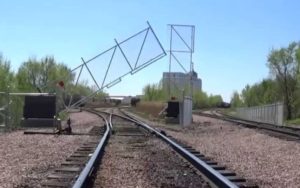Vertical pivot lift gates are the ultimate “no gap allowed” solution.
Vertical pivot lift gates are very lite weight gates that operate on a single pivot point that is located at the base of the opening. The gate pivots by lifting and vertically rotating on a single axis located at the base of the opening. To accomplish this opening and closing, the gate requires a vertical pivot gate operator. These operators are unique to the gate and designed to work together. The vertical pivot gate operator uses a highly tensioned large spring and long hydraulic cylinder to open the gate. When activated, the spring pulls the gate back and up. The hydraulic cylinder meters the motion. When closing, the cylinder pushes up and forward, tensioning the large spring.
Because vertical pivot lift gates practically lift straight up, the gate frame can be designed to meet the exact terrain of the ground below the gate. This makes these vertical pivot gates very popular with sites that require one hundred percent closure or absolutely no gaps such as airports and military bases. Vertical pivot lift gates have also become frequent on railroad installations. Railroad tracks are placed on a thick or tall base of ballast. This creates a very convex and jagged contour through the gate opening. Vertical lift gates have been fabricated to not only mirror the ballast but to work over and in the tracks, leaving a very small gap.
Vertical pivot lift gates require just a few feet of storage space along the gate opening. This is often less than half of the actual gate opening unlike a cantilever that requires one and half times the opening for storage. This also makes vertical pivot lift gates very practical for tight downtown parking lots.
In areas of the United States that receive a great deal of snow fall and are remote enough that the gates are not typically maintained, vertical pivot gates have become very popular. On ranches, these vertical pivot gates are an excellent choice when placed on solar power as these gates require little electrical demand with the hydraulic cylinder and offsetting spring gate operator installation. Vertical pivot gates do not slide or sweep, thus are not pushing snow when opening or closing.
The downside to this type of gate installation is the considerable concrete footing required to support the gate operator. This concrete footing is the anchor for the system that presents a great deal of stability . There is also a much greater cost with a vertical pivot gate installation. The gate operator is very large and it components are much more significant than a standard slide gate operator and the gate is engineered and fabricated to work with the operator’s components.
. There is also a much greater cost with a vertical pivot gate installation. The gate operator is very large and it components are much more significant than a standard slide gate operator and the gate is engineered and fabricated to work with the operator’s components.